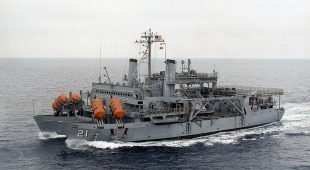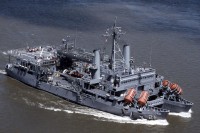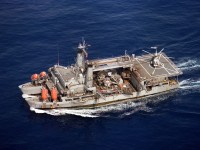Корабли спасения подводных лодок типа Pigeon
Основная информация
Главные размерения
Машина
- 4 * diesel engines
- 2 * shafts
Персонал
Боевые силы и средства
- 2 * 20 mm guns
- Helicopter platform only
The Pigeon-class submarine rescue vessels acted as surface support crafts for deep submergence rescue vehicles (DSRV's) during submarine rescue missions. These ships executed these tasks utilizing the McCann salvage module and also facilitated deep-sea diving activities. They had the capacity to transport, maintain, lower, and raise two Deep Submergence Rescue Vehicles and support diving operations to depths of 850 feet. These vessels could indefinitely sustain divers, transporting them to the seabed in pressurized transfer chambers for open-sea operations. Additionally, these ships operated as control hubs during deep-sea salvage missions.
Throughout much of the 20th century, submarines conducting sea trials were accompanied by a smaller vessel with a critical role. The auxiliary submarine rescue (ASR) ship shadowed the submarine, ready in case of emergencies. It served as a safety vessel, patrolling the area to caution other ships to steer clear of the submarine zone and retrieved practice torpedoes launched by the submarine. Divers onboard the ASR were on standby for potential submarine rescue tasks in case of accidents. Early in the century, there was no internationally recognized flag signal for this operation, hence all ASRs displayed the black fish insignia, becoming the «guardians of the submarines.» Eventually, they were officially authorized to showcase the distinctive black fish emblem alongside their hull numbers as a testament to their mission.
The Pigeon-class submarine rescue vessels were groundbreaking in their design and capabilities. Previously, submarine rescues involved sending divers to attach a steel cable and lower a small rescue capsule, the McCann chamber, capable of carrying approximately eight survivors to the surface when winched up to the rescue ship.
The Pigeon vessels could accommodate two Deep Submergence Rescue Vehicles, small submersibles that descended to the stricken submarine, evacuating up to 24 survivors per trip, transporting them either to the rescue ship or another submerged submarine. Moreover, the Pigeon housed the McCann chamber and the advanced Deep Diving System Mark II, allowing sustained diving activities to depths of 260 m. Earlier rescue ships supported shorter dives of about 91 m. To cater to extensive diving and submersible operations and enhance stability, the Pigeon-class ships were designed as catamarans, featuring twin hulls connected by a broad deck and superstructure. This design was also incorporated into a new oceanographic research vessel, the Hayes.
The two Pigeon-class ships were the world's first purpose-built vessels for submarine rescue missions and, apart from one Military Sealift Command ship, were the initial catamaran-hulled ships constructed for the Navy since Robert Fulton's Demologos in 1812.
The USS Pigeon (ASR-21) entered dry dock for refurbishment at the National Steel and Shipbuilding Company shipyard in April 1992 and was subsequently decommissioned.
The USS Ortolan (ASR-22) marked the end of an era in March 1995 as the final U.S. Navy auxiliary submarine rescue ship, concluding the distinguished legacy of these auxiliary vessels displaying the recognizable black fish emblem and faithfully standing by as guardians of the submarines for the majority of the century. However, the mission of submarine rescue continues through elements of Commander Submarine Development Group One, which includes the Deep Submergence Rescue Vehicles (DSRV) Mystic and Avalon, along with US Navy divers managing the fly-away submarine rescue chambers at the Deep Submergence Unit, North Island Naval Air Station, San Diego, CA.
The Navy's long-term shipbuilding plans do not include any new ASRs.
Корабли2
- Комментарии
 ru
ru en
en uk
uk


 Командование морских перевозок США
Командование морских перевозок США
